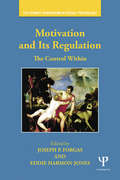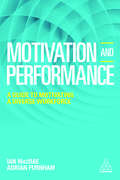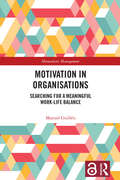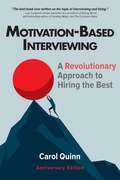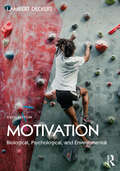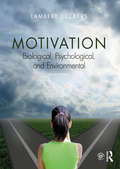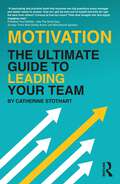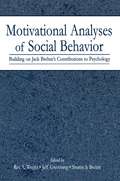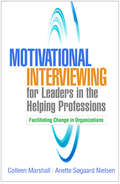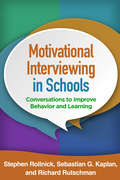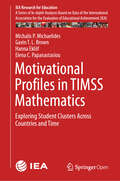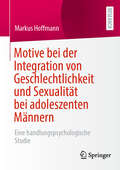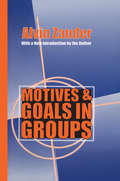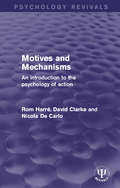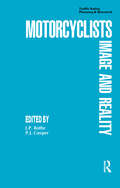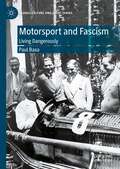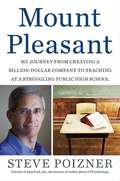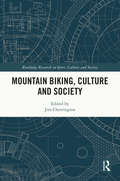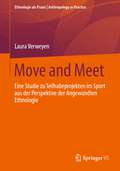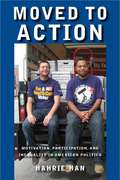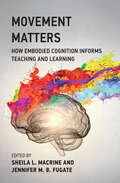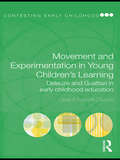- Table View
- List View
Motivation and Its Regulation: The Control Within (Sydney Symposium of Social Psychology)
by Eddie Harmon-Jones Joseph P. ForgasIt is motivation that drives all our daily endeavors, and it is motivation, or the lack of it, that accounts for most of our successes and failures. Motivation, however, needs to be carefully controlled and regulated to be effective. This book surveys the most recent psychological research on how motivational processes are regulated in daily life to achieve desired outcomes. Contributors are all leading international investigators, and they explore such exciting questions as: What is the relationship between motivation and self-control? What is the role of affect and cognition in regulating motivation? How do conscious and unconscious motivational processes interact? What role do physiological processes play in controlling motivation? How can we regulate aggressive impulses? How do affective states control motivation? Can motivation distort perception and attention? What are the social, cultural and interpersonal effects of motivational control? Understanding human motivation is not only of theoretical interest, but is also fundamental to applied fields such as clinical, counseling, educational, organizational, marketing and industrial psychology. The book is also suitable as an advanced textbook in courses in motivational sciences, and is recommended to students, teachers, researchers and applied professionals as well as laypersons interested in the psychology of human motivation and self-control.
Motivation and Performance: A Guide to Motivating a Diverse Workforce
by Adrian Furnham Ian MacraeMany organizations approach the issue of employee engagement and motivation by tapping into age, gender and other stereotypes. Motivation and Performance challenges these notions, bringing together evidence that group differences are often exaggerated and that getting to the heart of what really motivates individuals is what's most important. This book is a practical guide to ensuring that organizations consider all motivators - job security as well as the need for personal growth - to improve employee satisfaction, boost organizational productivity and reduce staff turnover.Underpinned by original research, Motivation and Performance features case studies from finance, retail, the public and other sectors to show how the principles of motivating employees apply at all levels of the organization, not just at the leadership level, and how values and motivation can be changed and developed. Complete with a framework for conducting effective visits to front-line locations, it will help HR professionals ask the right questions, choose whether to implement external motivation-building programmes and make a real impact on an employee's desire to progress in the company.
Motivation in Organisations: Searching for a Meaningful Work-Life Balance (Humanistic Management)
by Manuel GuillenMotivation in Organisations: Searching for a Meaningful Work-Life Balance extends the current motivation models in business education to include motives of human behaviour that have been neglected for decades. It debunks some of the myths about human motivation (self-interest as the dominant factor, amorality and non-spirituality) and explains why this approach to teaching business is erroneous and leads to wrong and harmful practices in many organisations. In a very personal and engaging style, the author presents a "map of motivations", based on a humanistic approach to management. This includes the latest findings of Abraham H. Maslow supported by sound philosophical reflections and modern research. He also presents specific ways of putting the framework into practice, sharing stories from students and professionals of how this framework has helped them better understand their own motivations and look at their daily work in a much more meaningful way. The book is highly relevant to students and researchers in humanistic management, people management, organisational behaviour, business ethics, corporate social responsibility and sustainability. In short, this text will be truly inspiring to anyone who wants to reflect on motivations in organisations and how to achieve a better work-life balance.
Motivation-based Interviewing: A Revolutionary Approach to Hiring the Best
by Carol QuinnHiring great talent takes more than checking qualifications - it requires uncovering who will truly excel. In Motivation-based Interviewing, hiring expert and popular keynote speaker Carol Quinn presents a proven approach for identifying top performers by evaluating not just skill, but also attitude toward overcoming obstacles and how passionate they are about achieving your goals - key indicators of long-term success. This definitive guide offers a reliable system to help interviewers expose subtle yet critical differences between average candidates and those who will thrive. With clear techniques and real-world insights, Quinn equips HR professionals, hiring managers and recruiters to make smarter, more confident hiring decisions.If your goal is to build a high-performance team, this book is your ultimate hiring handbook.
Motivation: Biological, Psychological, and Environmental
by Lambert DeckersMotivation provides an accessible introduction to motivation and emotion, combining classic studies with current research and uses numerous real-world examples to engage the student and make, often difficult, theoretical concepts come to life. By understanding and applying the principles of motivation described in the text, students will not only discover insights into what motivates their own behavior but also how to instigate self-change through goal-setting. Throughout the book the author adopts an evolutionary approach to explore the effect of interpersonal relationships, food preferences, fear, music, and the emotions on motivation, at the same time considering how personality traits and psychological needs are essential for understanding why people are motivated by different things. The motivation of compulsive behavior from addictions, such as drugs, gambling, Internet gaming, and obsessive exercise is also considered, providing a truly comprehensive overview of biological, psychological, and environmental sources of motivation. The sixth edition has been thoroughly updated throughout and is accompanied by an instructor’s manual that contains multiple choice questions, essay questions with answers, websites related to motivation and emotion, power point slides, in-class activities, and discussion questions. It is an essential read for all students of motivation.
Motivation: Biological, Psychological, and Environmental (Mysearchlab Series 15% Off Ser.)
by Lambert DeckersThis textbook provides a complete overview of motivation and emotion, using an overarching organizational scheme of how biological, psychological, and environmental sources become motivation—the inducement of behavior, feelings, and cognition. It combines classic studies with current research and uses numerous real-world examples to engage the student and make often-difficult theoretical concepts come to life. By understanding and applying the principles of motivation described in the text, students will not only discover insights into what motivates their own behavior but also how to instigate self-change. Thoroughly revised and updated throughout, this fifth edition provides a major review of recent research, with over 225 new references, including expansion in the areas of goal motivation and emotion psychology. Other updated topics include new findings and interpretations on how evolution affects our preferences, how personality traits determine motivation, and how self-control depends on a cost/benefit analysis. The addition of individual chapter glossaries and an increased number of links to additional resources supplement student learning. This textbook is suitable as a primary text for courses on motivation. For additional resources, please consult the companion website at www.routledge.com/cw/deckers.
Motivation: The Brian Tracy Success Library (The\brian Tracy Success Library)
by Brian TracyAs a manager, your overall goal for each day with your team is to maximize the productivity and quality that they are capable of producing. And despite a thorough hiring process, training that is second to none, and competitive compensation, you probably still find yourself at times with an underperforming lackluster group of paycheck collectors, with absenteeism and turnover levels too high to maintain any kind of consistent progress.But perhaps the problem is not in your team or their capabilities . . . but in you. How are you intentionally motivating them to greatness?As a manager, one of your most important responsibilities is to motivate your employees to do their absolute best. Managers who create positive, rewarding, high-energy environments will find their employees longing to excel at work and to contribute to the overall mission.In Motivation, success expert Brian Tracy draws on his decades of experience bringing out the best in others to provide 21 of the fastest, most powerful methods ever discovered for increasing the effectiveness of any individual or group. Inside this efficient, easy-to-read guide, managers will learn how to:Ensure employees look forward to coming to work and feel passionate about what they doChallenge them with tasks that allow them to stretchSatisfy their need to feel both autonomous and part of a greater wholeReduce their fear of failure while increasing their desire to take risksRemove obstacles that suppress promising employeesProvide the regular feedback they need to succeedAnd much more!More than likely, you already have the team you need to take your company to the next level of success. They are just waiting for someone to come along and inspire them to greatness. Packed with proven tools and strategies, this essential guide helps any manager deliver a shot of adrenaline straight to the heart of his or her work team.
Motivation: The Ultimate Guide to Leading Your Team
by Catherine StothartMotivation is regarded as a cornerstone of performance in the workplace, both personally and for organisations. If you are a leader, manager, or HR professional, this book will show you how to tap into what motivates every individual so that you can enable them to use their talents and fulfil their potential. You will also learn more about your own motivation and how this impacts your leadership style. Written by bestselling author and leadership coach, Catherine Stothart, this book captures the essence of motivation in an insightful and practical way. You will learn specific tools and techniques for four key management capabilities – how to engage, develop, delegate to, and connect with your teams. You will also find out how to sustain your own motivation and be resilient through setbacks. Using activities, case studies, models, tools, tips, and templates for practical action, this book is ideal for those who want to know how to motivate their teams, improve their well-being, and feel motivated themselves. It is also invaluable to HR managers, executive and life coaches, and learning and development professionals.
Motivational Analyses of Social Behavior: Building on Jack Brehm's Contributions to Psychology
by Jeff Greenberg Rex A. Wright Sharon S. BrehmThis book honors Jack W. Brehm's contributions to psychology, all of which revolve around a central theme of motivation and social behavior. It begins with two personal chapters and then presents a collection of cutting-edge, substantive chapters authored by researchers whose work Brehm has strongly influenced. It concludes with a chapter by Jack Brehm that reflects on the field of psychology, discusses a new theory of social influence, and offers ideas about the direction in which our understanding of human behavior could move. Motivational Analyses of Social Behavior will be of value to research scientists, educators, and practitioners interested in social motivational processes and those who developed major theories in this area. Interested readers include individuals specializing in social, clinical, organizational, personality, health, and motivational psychology, and psychophysiology. The book would also be ideal for advanced courses on social motivation and the history of psychology.
Motivational Interviewing for Leaders in the Helping Professions: Facilitating Change in Organizations (Applications of Motivational Interviewing)
by Colleen Marshall Anette Søgaard NielsenWritten expressly for leaders in health care and the social services, this accessible book shows how motivational interviewing (MI) can transform conversations about change within an organization. The authors demonstrate powerful ways to use MI to generate solutions and get employees and organizations unstuck, whether mentoring a staff member in a new role, addressing performance problems, or redesigning procedures or programs. Readers are guided to skillfully and ethically apply the core MI processes--engaging, focusing, evoking, and planning--in the management context. User-friendly features include reproducible worksheets, end-of-chapter self-reflection exercises, and extended case vignettes. Purchasers get access to a companion website where they can download and print these materials in a convenient 8 ½" x 11" size. This book is in the Applications of Motivational Interviewing series, edited by Stephen Rollnick, William R. Miller, and Theresa B. Moyers.
Motivational Interviewing in Schools: Conversations to Improve Behavior and Learning
by Stephen Rollnick Richard Rutschman Sebastian G. KaplanThe first teacher's guide to the proven counseling approach known as motivational interviewing (MI), this pragmatic book shows how to use everyday interactions with students as powerful opportunities for change. MI comprises skills and strategies that can make brief conversations about any kind of behavioral, academic, or peer-related challenge more effective. Extensive sample dialogues bring to life the "dos and don'ts" of talking to K-12 students (and their parents) in ways that promote self-directed problem solving and personal growth. The authors include the distinguished codeveloper of MI plus two former classroom teachers. User-friendly features include learning exercises and reflection questions; additional helpful resources are available at the companion website. Written for teachers, the book will be recommended and/or used in teacher workshops by school psychologists, counselors, and social workers.
Motivational Profiles in TIMSS Mathematics: Exploring Student Clusters Across Countries and Time (IEA Research for Education #7)
by Gavin T. Brown Michalis P. Michaelides Hanna Eklöf Elena C. PapanastasiouThis open access book presents a person-centered exploration of student profiles, using variables related to motivation to do school mathematics derived from the IEA’s Trends in International Mathematics and Science Study (TIMSS) data. Statistical cluster analysis is used to identify groups of students with similar motivational profiles, across grades and over time, for multiple participating countries.While motivational variables systematically relate to school outcomes, linear relationships can obscure the diverse makeup of student subgroups, each with varying combinations of motivation, emotions, and attitudes. In this book, a person-centered analysis of distinct and meaningful motivational profiles and their differences on sociodemographic variables and mathematics performance broadens understanding about the role that motivation characteristics play in learning and achievement in mathematics. Exploiting the richness of IEA’s TIMSS data from many countries, extracted clusters reveal consistent, as well as certain nuanced patterns that are systematically linked to sociodemographic and achievement measures. Student clusters with inconsistent motivational profiles were found in all countries; mathematics self-confidence then emerged as the variable more closely associated with average achievement. The findings demonstrate that teachers, researchers, and policymakers need to take into account differential student profiles, prioritizing techniques that target skill and competence in mathematics, in educational efforts to develop student motivation.
Motive bei der Integration von Geschlechtlichkeit und Sexualität bei adoleszenten Männern: Eine handlungspsychologische Studie
by Markus HoffmannGegenstand der Studie ist die Integration von Geschlechtlichkeit und Sexualität adoleszenter Männer im Kontext von Alltag und Alltagshandlungen. Auf der Basis der handlungstheoretischen Entwicklungspsychologie wird in dieser qualitativen Forschungsarbeit die These vertreten, dass der Adoleszente das Werk seiner selbst ist, der die Entwicklung und die Integration seiner Sexualität und Geschlechtsidentität im Alltag vorantreibt. An der Studie nahmen 50 Männer im Alter von 13 bis 25 Jahren teil. Die Arbeit zeigt, wie sich die Motive, die Entwicklungsaufgaben und Bewältigungs- und Handlungsformen bei der Integration der körperlichen Veränderung, der Entwicklung von romantischen Beziehungen, dem Lernen von Sexualität und der Entwicklung der Geschlechtsrolle über die Spanne der Adoleszenz aus der Sicht junger Männer verändern. Durch die Generierung von Handlungstypen machen die Ergebnisse die psychische und soziale Auseinandersetzung in verschiedenen Phasen der Adoleszenz sichtbar, wie deren Veränderung über die Zeit. Die Forschungsarbeit greift auf innovative Weise ein Thema von wissenschaftlicher und praktischer Relevanz auf, das bisher nicht in dieser differenzierten Form empirisch untersucht wurde.
Motives and Goals in Groups
by Alvin ZanderThe qualities and effectiveness of working groups are determined by the goals of the group and the motives of its members. In Motives and Goals In Groups, Alvin Zander studies the effects of group goals and the reasons why particular group goals are chosen. He examines the origins of such goals, determines their value in terms of the work of the group, and analyzes how goals are affected by members' aspirations to achieve success. Zander assumes the idea that the motives of members are not merely dispositions to obtain personal satisfaction, but are also inclinations to achieve group success.Earlier studies defined and clarified concepts about group achievement. They report on work in the laboratory, using high school students as subjects. In later investigations, these concepts were tested in groups outside the laboratory classrooms, executive boards, industrial crews, and business departments.In the new introduction, Zander brings his book up to date by analyzing members' motives and groups' goals from 1971 to the present day. He examines how current findings amplify results reported in the original book. Among the topics covered are: measurability of a group's objective; the degree of members' confidence in attaining the group's goal; the importance of a group's purpose; external pressures on a group's aspirations; and the reaction of members to their group's performance.Motives and Goals in Groups brings together earlier research for the first careful, scientific study of goals In groups. It is of continuing importance to psychologists, educators, social workers, executives, therapists, and all others who work either in or with groups.
Motives and Mechanisms: An Introduction to the Psychology of Action (Psychology Revivals)
by David Clarke Rom Harré Nicola De CarloAs the first introductory statement of the ‘new psychology’, Motives and Mechanisms, originally published in 1985, aims to bring the study of human action to the forefront of the subject. Like any science, the practice of psychology is very much influenced by the hidden assumptions of its practitioners. The argument put forward in this important text shows how these assumptions can be brought out by comparing psychology with the natural sciences and with common-sense understanding. In pursuing the integration of traditional research methods with a new style of investigation, the basic principle is that social structures and mental structures are in reciprocal relation with one another because each is involved in the creation of the other. By adopting this principle social structures become the basis for research into the cognitive and emotional organization of mind. The authors devote two key chapters to the central question that underlies this stance: are human actions and human actors’ products of internal processes, such as those described by Freud, or of external social forces, of the kind described by Mead?
Motor Cyclists: Image and Reality
by J. Peter Rothe Peter J. CooperFirst published in 1989, the main thrust in this volume has been to denote and elucidate a source of information on motorcyclists・a source which the editors believe is particularly rich with data about characteristics, images and everyday social behaviors.
Motorsport and Fascism: Living Dangerously (Global Culture and Sport Series)
by Paul BaxaThis book is the first English-language study of motorsport and Italian Fascism, arguing that a synergy existed between motor racing and Fascism that did not exist with other sports. Motorsport was able to bring together the two dominant, and often opposed, cultural roots of Fascism, the Futurism of F. T. Marinetti, and the Decadence associated with Gabriele D’Annunzio. The book traces this cultural convergence through a topical study of motorsport in the 1920s and 1930s placing it in the context of the history of sport under Mussolini’s regime. Chapters discuss the centrality of speed and death in Fascist culture, the attempt to transform Rome into a motorsport capital, the architectural and ideological function of the Monza and Tripoli and autodromes, and two chapters on the importance of the Mille Miglia, a genuine Fascist artefact that became one of the most legendary motor races of all time.
Mount Pleasant: My Journey from Creating a Billion-dollar Company to Teaching at a Struggling Public High School
by Steve PoiznerA Silicon Valley entrepreneur takes on the challenge of a lifetime: teaching in one of California's toughest high schools. Entrepreneur Steve Poizner has run a billion dollar company, but the greatest challenge of his life was the year he spent teaching twelfth graders at San Jose's Mt. Pleasant High School. On many days, like the one when a student's boyfriend was arrested for bank robbery, his managerial and entrepreneurial skills seemed irrelevant. But on others, they helped him demonstrate how exciting it is to learn. Playing Jeopardy with the class and inviting speakers into the classroom, Poizner motivated his students by expanding their horizons far beyond their high school's walls. Steve Poizner is currently a candidate for governor of California and on the verge of becoming a household name. But this is a memoir of a riveting personal journey, not a point-by-point account of his vision for his state. Poizner writes, "Often I came to ask myself one question: What exactly are you doing here? As it turns out, I was receiving one hell of an education. " Mt Pleasant is ultimately a success story, as Poizner wins Rookie Teacher of the Year honors and, more important, ensures that all his students graduate.
Mountain Arapesh: Socio-economic Life And Diary Of Events In Alitoa
by Margaret MeadFor approximately eight months during 1931-1932, anthropologist Margaret Mead lived with and studied the Mountain Arapesh-a segment of the population of the East Sepik Province, Papua New Guinea. She found a culture based on simplicity, sensitivity, and cooperation. In contrast to the aggressive Arapesh who lived on the plains, both the men and the women of the mountain settlements were found to be, in Mead's word, maternal. The Mountain Arapesh exhibited qualities that many might consider feminine: they were, in general, passive, affectionate, and peaceloving. Though Mead partially explains the male's "femininity" as being due to the type of nourishment available to the Arapesh, she maintains social conditioning to be a factor in the type of lifestyle led by both sexes. Mead's study encapsulates all aspects of the Arapesh culture. She discusses betrothal and marriage customs, sexuality, gender roles, diet, religion, arts, agriculture, and rites of passage. In possibly a portent for the breakdown of traditional roles and beliefs in the latter part of the twentieth century, Mead discusses the purpose of rites of passage in maintaining societal values and social control. Mead also discovered that both male and female parents took an active role in raising their children. Furthermore, it was found that there were few conflicts over property: the Arapesh, having no concept of land ownership, maintained a peaceful existence with each other. In his new introduction to The Mountain Arapesh, Paul B. Roscoe assesses the importance of Mead's work in light of modern anthropological and ethnographic research, as well as how it fits into her own canon of writings. Roscoe discusses findings he culled from a trip to Papua New Guinea in 1991 to clarify some ambiguities in Mead's work. His travels also served to help reconstruct what had happened to the Arapesh since Mead's historic visit in the early 1930s.
Mountain Biking, Culture and Society (Routledge Research in Sport, Culture and Society)
by Jim CherringtonThis book represents the first critical examination of the social, cultural, and political significance of mountain biking in contemporary societies. Starting from the premise that cultures of mountain biking are diverse, complex, and at times contradictory, this book offers practical and theoretical insights into a range of embodied, material, and socio-technical relationships. Featuring contributions from an interdisciplinary team of researchers, artists, and (Indigenous) community members with backgrounds in sociology, anthropology, cultural studies, community development, and coaching, chapters critically unpack the complex and contested nature of mountain biking identities, bodies, environments, and inequalities within specific settings. Via a range of international case studies from England, Scotland, America, Canada, New Zealand, and South Africa, authors highlight how tensions and conflicts in the world of mountain biking initiate important conversations about climate change, colonialism, discrimination, and land-use. This is essential reading for academics and practitioners in sociology, cultural studies, sport-for-development, and human geography.
Move and Meet: Eine Studie zu Teilhabeprojekten im Sport aus der Perspektive der Angewandten Ethnologie (Ethnologie als Praxis | Anthropology as Practice)
by Laura Verweyen„Move and Meet“ – der Titel dieser Arbeit ist zugleich der Name eines Sport- und Bildungsvereins, der sich im Rahmen der Forschungen zur vorliegenden Studie im Jahr 2021 gründete. Der Verein ist damit das Produkt eines Teilhabe-Experiments, das 2017 in einem ersten Sportkurs für Frauen mit Fluchterfahrung seinen Anfang nahm. Dieser wurde als anwendungsorientierter Teil der vorliegenden Studie im Bereich der Angewandten Ethnologie konzipiert und entwickelte sich zu einem Begegnungs- und Empowerment-Raum, der auf den Motiven und Bedarfen der Sportlerinnen, der haupt- und ehrenamtlichen Trainerinnen und weiterer Engagierter beruhte. Diese Studie zeigt auf, welchen Beitrag der Sport für die soziale und gesellschaftliche Teilhabe von Menschen mit Migrations- und Fluchterfahrung und insbesondere für Frauen mit Fluchterfahrung leisten kann. Repräsentation und Partizipation, Ressourcen, Sportmotive und -bedarfe sowie die Kommunikation und Interaktion von Sportler:innen und Engagierten werden in den Blick genommen. Die Bedeutung einer diversitätssensiblen Vereinsentwicklung für den Sportverein als Sport-, Begegnungs- und Bildungsakteur wird herausgearbeitet.
Moved to Action
by Hahrie C. HanHan (political science, Wellesley College and health policy, Harvard U. ) investigates how people without many educational, financial, and civic resources become engaged to participate in politics. Many studies show the most people who participate in politics are interested in it, have the resources, and are asked; she looks at people who have none of that, but dive in anyway. She covers the challenge of political equality, theoretical foundations, issue publics and the distribution of political motivation, an empirical look at issue publics and participation, pathways to participation, and looking ahead. Her case studies come from a wide range of issues, organizations, and campaigns. Annotation c2010 Book News, Inc. , Portland, OR (booknews. com)
Movement Matters: How Embodied Cognition Informs Teaching and Learning
by Edited by Sheila L. Macrine and Jennifer M. B. FugateExperts translate the latest findings on embodied cognition from neuroscience, psychology, and cognitive science to inform teaching and learning pedagogy.Embodied cognition represents a radical shift in conceptualizing cognitive processes, in which cognition develops through mind-body environmental interaction. If this supposition is correct, then the conventional style of instruction—in which students sit at desks, passively receiving information—needs rethinking. Movement Matters considers the educational implications of an embodied account of cognition, describing the latest research applications from neuroscience, psychology, and cognitive science and demonstrating their relevance for teaching and learning pedagogy. The contributors cover a range of content areas, explaining how the principles of embodied cognition can be applied in classroom settings. After a discussion of the philosophical and theoretical underpinnings of embodied cognition, contributors describe its applications in language, including the areas of handwriting, vocabulary, language development, and reading comprehension; STEM areas, emphasizing finger counting and the importance of hand and body gestures in understanding physical forces; and digital learning technologies, including games and augmented reality. Finally, they explore embodied learning in the social-emotional realm, including how emotional granularity, empathy, and mindfulness benefit classroom learning. Movement Matters introduces a new model, translational learning sciences research, for interpreting and disseminating the latest empirical findings in the burgeoning field of embodied cognition. The book provides an up-to-date, inclusive, and essential resource for those involved in educational planning, design, and pedagogical approaches. ContributorsDor Abrahamson, Martha W. Alibali, Petra A. Arndt, Lisa Aziz-Zadeh, Jo Boaler, Christiana Butera, Rachel S. Y. Chen,Charles P. Davis, Andrea Marquardt Donovan, Inge-Marie Eigsti, Virginia J. Flood, Jennifer M. B. Fugate, Arthur M. Glenberg, Ligia E. Gómez, Daniel D. Hutto, Karin H. James, Mina C. Johnson-Glenberg, Michael P. Kaschak, Markus Kiefer, Christina Krause, Sheila L. Macrine, Anne Mangen, Carmen Mayer, Amanda L. McGraw, Colleen Megowan-Romanowicz, Mitchell J. Nathan, Antti Pirhonen, Kelsey E. Schenck, Lawrence Shapiro, Anna Shvarts, Yue-Ting Siu,Sofia Tancredi, Chrystian Vieyra, Rebecca Vieyra, Candace Walkington, Christine Wilson-Mendenhall, Eiling Yee
Movement and Experimentation in Young Children's Learning: Deleuze and Guattari in Early Childhood Education (Contesting Early Childhood)
by Liselott Mariett OlssonIn contemporary educational contexts young children and learning are tamed, predicted, supervised, controlled and evaluated according to predetermined standards. Contesting such intense governing of the learning child, this book argues that the challenge to practice and research is to find ways of regaining movement and experimentation in subjectivity and learning. Vivid examples from Swedish preschools – involving children, teachers, teacher students and educators and researchers - are woven together with the theories of French philosophers Gilles Deleuze and Félix Guattari, bringing important new concepts and practices to the early childhood field. This ground-breaking book investigates three key areas: the need to focus on ‘process’ rather than ‘position’, as positioning of any kind, such as learning goals or developmental stages, hampers movement. working with methods that recognise science’s inventiveness and productivity, demonstrating how the events in which children take part can remain open ended and in movement. Re-considering the dichotomy between the individual and society as a ‘cause and effect’ relationship, which immobilizes subjectivity and learning and hinders experimentation. Challenging dominant ways of thinking, Movement and Experimentation in Young Children's Learning offers new possibilities for change and provokes a re-evaluation of the educational system’s current emphasis on predetermined outcomes and fixed positions. This book provides researcher and students with a sound theoretical framework for re-conceptualising significant aspects of movement and experimentation in early childhood. Its many practical illustrations make this a compelling and provocative read for and student taking course in Early Childhood Studies.
Movements for Human Rights: Locally and Globally
by David L. Brunsma, Keri E. Iyall Smith and Brian K. GranHow do people work together to advance human rights? Do people form groups to prevent human rights from being enforced? Why? In what ways do circumstances matter to the work of individuals collectively working to shape human rights practices? Human society is made of individuals within contexts—tectonic plates not of the earth’s crust but of groups and individuals who scrape and shift as we bump along, competing for scarce resources and getting along. These movements, large and small, are the products of actions individuals take in communities, within families and legal structures. These individuals are able to live longer, yet continue to remain vulnerable to dangers arising from the environment, substances, struggles for power, and a failure to understand that in most ways we are the same as our neighbors. Yet it is because we live together in layers of diverse communities that we want our ability to speak to be unhindered by others, use spirituality to help us understand ourselves and others, possess a space and objects that are ours alone, and join with groups that share our values and interests, including circumstances where we do not know who our fellow neighbor is. For this reason sociologists have identified the importance of movements and change in human societies. When we collaborate in groups, individuals can change the contours of their daily lives. Within this book you will find the building blocks for human rights in our communities. To understand why sometimes we enjoy human rights and other times we experience vulnerability and risk, sociologists seek to understand the individual within her context. Bringing together prominent sociologists to grapple with these questions, Movements for Human Rights: Locally and Globally, offers insights into the ways that people move for (and against) human rights.
